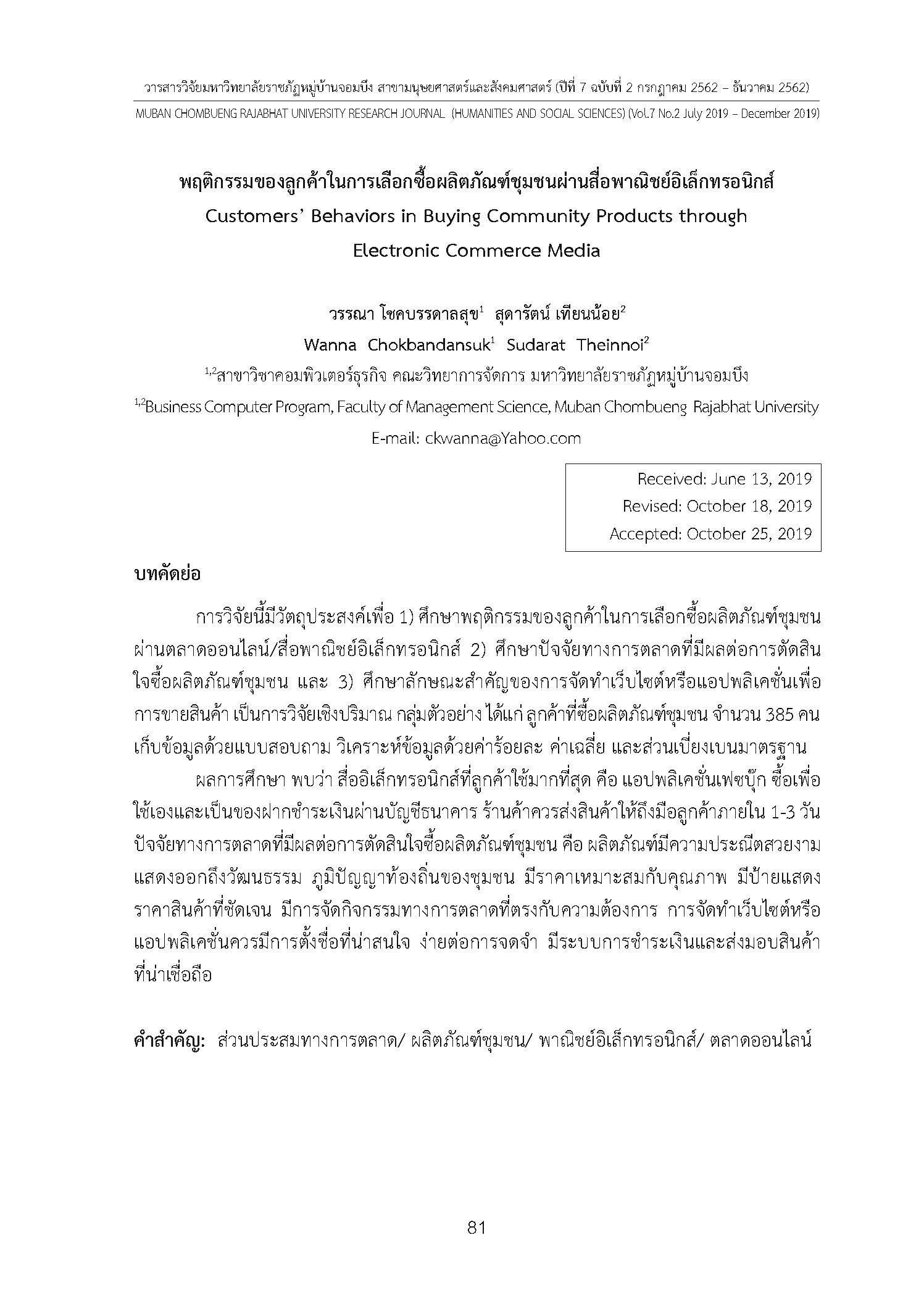พฤติกรรมของลูกค้าในการเลือกซื้อผลิตภัณฑ์ชุมชนผ่านสื่อพาณิชย์อิเล็กทรอนิกส์
คำสำคัญ:
ส่วนประสมทางการตลาด, ผลิตภัณฑ์ชุมชน, พาณิชย์อิเล็กทรอนิกส์, ตลาดออนไลน์บทคัดย่อ
การวิจัยนี้มีวัตถุประสงค์เพื่อ 1) ศึกษาพฤติกรรมของลูกค้าในการเลือกซื้อผลิตภัณฑ์ชุมชนผ่านตลาดออนไลน์/สื่อพาณิชย์อิเล็กทรอนิกส์ 2) ศึกษาปัจจัยทางการตลาดที่มีผลต่อการตัดสินใจซื้อผลิตภัณฑ์ชุมชน และ 3) ศึกษาลักษณะสำคัญของการจัดทำเว็บไซต์หรือแอปพลิเคชั่นเพื่อการขายสินค้า เป็นการวิจัยเชิงปริมาณ กลุ่มตัวอย่าง ได้แก่ ลูกค้าที่ซื้อผลิตภัณฑ์ชุมชน จำนวน 385 คน เก็บข้อมูลด้วยแบบสอบถาม วิเคราะห์ข้อมูลด้วยค่าร้อยละ ค่าเฉลี่ย และค่าเบี่ยงเบนมาตรฐาน
ผลการศึกษา พบว่า สื่ออิเล็กทรอนิกส์ที่ลูกค้าใช้มากที่สุด คือ แอพพลิเคชั่นเฟซบุ๊ก ซื้อเพื่อใช้เองและเป็นของฝาก ชำระเงินผ่านบัญชีธนาคาร ร้านค้าควรส่งสินค้าให้ถึงมือลูกค้าภายใน 1-3 วัน ปัจจัยทางการตลาดที่มีผลต่อการตัดสินใจซื้อผลิตภัณฑ์ชุมชน คือ ผลิตภัณฑ์มีความประณีตสวยงาม แสดงออกถึงวัฒนธรรม ภูมิปัญญาท้องถิ่นของชุมชน มีราคาเหมาะสมกับคุณภาพ มีป้ายแสดงราคาสินค้าที่ชัดเจน มีการจัดกิจกรรมทางการตลาดที่ตรงกับความต้องการ การจัดทำเว็บไซต์หรือแอปพลิเคชั่นควรมีการตั้งชื่อที่น่าสนใจ ง่ายต่อการจดจำ มีระบบการชำระเงินและส่งมอบสินค้าที่น่าเชื่อถือ
เอกสารอ้างอิง
ณัฐพล ใยไพโรจน์. (2558). Digital Marketing: Concept & Case Study อัพเดต 2015.
นนทบุรี: ไอดีซี พรีเมียร์.
ทวีศักดิ์ กาญจนสุวรรณ. (2552). การพาณิชย์อิเล็กทรอนิกส์. กรุงเทพฯ: เคทีพีคอมพ์แอนด์คอนซัลท์.
นิเวศน์ ธรรมะ และคณะ. (2552). การจัดการตลาด. กรุงเทพฯ: แมคกรอ-ฮิล.
ปาริชาต สุพรหม. (2550). การนำระบบพาณิชย์อิเล็กทรอนิกส์มาใช้เพื่อส่งเสริมการจำหน่ายผลิตภัณฑ์เบญจรงค์ในโครงการหนึ่งตำบลหนึ่งผลิตภัณฑ์ของกลุ่มเยาวชนสหกรณ์บ้านหนองบัว จังหวัดกาญจนบุรี. วิทยานิพนธ์ศิลปศาสตรมหาบัณฑิต, สาขาเศรษฐศาสตร์สหกรณ์ มหาวิทยาลัยเกษตรศาสตร์.
วิทวัส รุ่งเรืองผล และวรสุดา คำเป็ก. (2558). พฤติกรรมการเลือกซื้อเครื่องประดับของชาวรัสเซียผ่านพาณิชย์อิเล็กทรอนิกส์. วารสารบริหารธุรกิจ มหาวิทยาลัยธรรมศาสตร์. 38(148), 39-56.
สุพัฒธณา สุขรัตน์. (2555). รายงานการวิจัยเรื่อง แนวทางการดำเนินธุรกิจพาณิชย์อิเล็กทรอนิกส์ สำหรับกลุ่มสินค้าหนึ่งตำบลหนึ่งผลิตภัณฑ์เพื่อความได้เปรียบทางธุรกิจ. สงขลา: มหาวิทยาลัยสงขลานครินทร์.
Bamini, K. B., Dahnil, M. I. & Yi, W. J. (2013). the impact of social media marketing medium toward purchase intention and brand loyalty among generation Y. Procedia-Social and Behavioral Sciences. 148, 177–185.
Best, J. W. (1986). Research in education. New Jersey: Prentic Hall.
Cochran, W. G. (1977). Sampling techniques. (3rd ed.). New York: John Wiley & Sons.
Cronbach, L. J. (1960). Essentials of psychological testing. New York: Harper & Row.
Kotler, P. (2010). Marketing management. New Jersey: Prentice Hall.
¬¬¬¬¬¬¬¬¬_______. (2003). Marketing management. (11th ed.). New Jersey: Prentice-Hall International.

ดาวน์โหลด
เผยแพร่แล้ว
รูปแบบการอ้างอิง
ฉบับ
ประเภทบทความ
สัญญาอนุญาต
วารสาร TCI อยู่ภายใต้การอนุญาต Creative Commons Attribution-NonCommercial-NoDerivatives 4.0 International (CC BY-NC-ND 4.0) เว้นแต่จะรุบุไว้เป็นอย่างอื่นโปรดอ่านหน้านโยบายของเราสำหรับข้อมูลเพิ่มเติมเกี่ยวกับการเช้าถึงแบบเปิด ลิขสิทธิ์ และการอนุญาต


